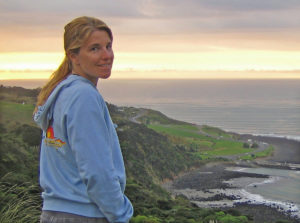
How long have you collaborated with JGI?
I started collaborating with JGI in the Fall of 2013 as part of a Facilities Integrating Collaborations for User Science (FICUS) award between JGI and the Environmental Molecular Sciences Laboratory (EMSL). (Click here to learn more about her approved FICUS proposal.)
We have been working with the JGI on genomic and transcriptome studies of a unique group of manganese (Mn) oxidizing Ascomycete fungi that were isolated from coal mine drainage treatment systems and metal-laden freshwater ponds. The overall goal of the project is to understand the enzymatic pathways involved in the oxidation of soluble Mn(II) to Mn(III/IV) oxides – a highly reactive group of minerals responsible for sequestration of contaminants and degradation of even the most recalcitrant forms of organic carbon. Learn more in this Science Highlight: https://archive.jgi.doe.gov/comparing-fungal-secretions-uncover-carbon-compound-degradation-pathways/

Click on the image to watch Colleen Hansel’s talk from the 2017 DOE JGI Genomics of Energy & Environment Meeting on the JGI YouTube channel, or go to http://bit.ly/JGI2017Hansel.
Why is this research important?
Fungi are critically important in ecosystem functioning where they are primary degraders of carbon, control CO2 fluxes from soils, and form both synergistic and antagonistic (pathogenic) relationships with microbes, plants, and animals. Fungi also hold great promise in biofuel production, biomedicine and natural product discovery. In order to utilize fungi for environmental and technological gain, however, the mechanisms and pathways by which these organisms influence biogeochemical cycles and interact with the surrounding environment must be established. The Ascomycete fungi form one of the most widespread and developed groups of eukaryotes as a consequence of an extensive evolutionary history (~ one billion years), immense diversity (nearly one million species), and vast biomass rivaling that of animals on earth. Obtaining a molecular level physiological understanding of these ubiquitous organisms will improve our understanding of terrestrial and freshwater biogeochemistry, increase our predictive capacity of carbon degradation and metal cycling in response to a globally changing environment, and point to target processes for carbon and contaminant mitigation strategies.
What do you value about JGI’s contributions?
The staff and facilities at the JGI were critical for conducting this research. This partnership made possible the sequencing and analysis of several novel fungal genomes and transcriptomes – allowing for broad-scale physiological comparisons, as well as enabling targeted proteomic analysis of key Mn and carbon oxidation metabolic networks in collaboration with staff at EMSL.